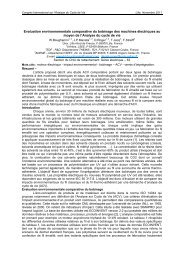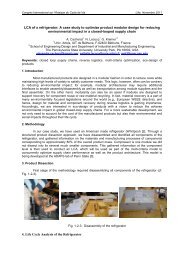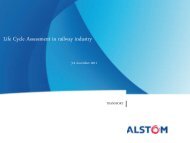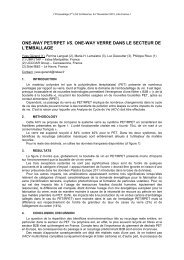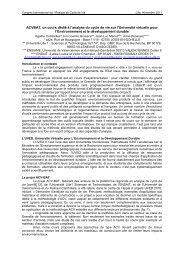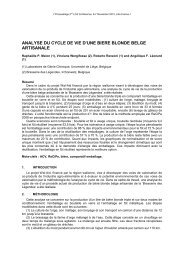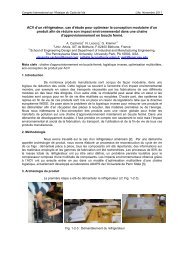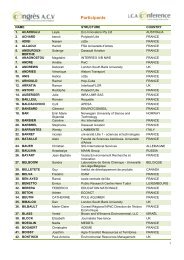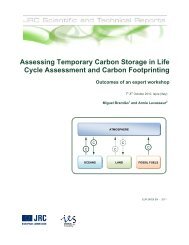Untitled - avniR
Untitled - avniR
Untitled - avniR
Create successful ePaper yourself
Turn your PDF publications into a flip-book with our unique Google optimized e-Paper software.
CO2 Footprint (kg)<br />
CO2 Footprint (kg)<br />
Congrès International sur l’Analyse du Cycle de Vie Lille, Novembre 2011<br />
The RDC in the model is used for 3 years (continuously) in the UK (electricity mix). The transport<br />
of the components is assumed to be single trips from their respective blast furnaces.<br />
Results:<br />
The results corroborate the findings from previous studies (Youbi-Idrissi et al. (2007); Watkins and<br />
Tassou (2006)) stating that the use phase has the dominant impact. However, remanufacturing and<br />
refurbishment have the potential to be repeated several times. After one refurbishment iteration, 633 kg of<br />
CO 2e are saved.<br />
Table 5 Summary table total carbon footprints and energy used for alternative EoL of the Chicago 1.2m<br />
Energy (MJ) CO 2 (kg)<br />
EoL scenario 1 232,688.7 14,511.2<br />
EoL scenario 2 221,117 13,877.9<br />
16000<br />
14000<br />
12000<br />
10000<br />
8000<br />
6000<br />
4000<br />
2000<br />
0<br />
-2000<br />
14 600,00<br />
14 500,00<br />
14 400,00<br />
14 300,00<br />
14 200,00<br />
14 100,00<br />
14 000,00<br />
13 900,00<br />
13 800,00<br />
13 700,00<br />
13 600,00<br />
13 500,00<br />
Total Carbon<br />
Footprint<br />
EoL Scenario 1<br />
EoL Scenario 2<br />
Figure 10 Chicago carbon footprint broken down by life<br />
phase<br />
Figure 11 Chicago total carbon footprint<br />
Conclusion:<br />
Carbon savings from remanufacturing and refurbishment are marginal in proportion to those<br />
produced during the use phase but they are physically significant and one iteration results in a saving of<br />
633 kg CO 2e . Nonetheless, supermarkets can significantly reduce the environmental impacts of RDCs by<br />
adopting a holistic view of their life cycles, which, at the same time prolongs their lifespan. (One has to<br />
bear in mind that, larger supermarkets (hypermarkets) use a greater number of RDCs). Therefore the<br />
repeated remanufacture and refurbishment, in conjunction with the retrofitting of the best available<br />
techniques (that do not entail excessive costs (BATNEET)) will simultaneously reduce embodied carbon,<br />
and indirect and direct emissions. Furthermore, there is a need to carry out an analysis of systematic<br />
materials substitution for the least carbon intensive option that does not entail excessive costs. Further<br />
empirical data are needed to validate the argument presented. It is anticipated that the project will<br />
progress toward the life cycle sustainability assessment of RDCs with the purpose of providing economic<br />
and social data for RDC procurement decisions.<br />
Key Words: Refrigerated Display Cabinets-Remanufacturing- Carbon Footprint-Life Cycle Thinking-<br />
Grocery Retail<br />
54



